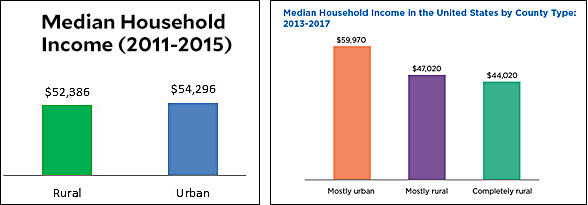In the New York Times, Will Wilkinson writes about the steadily worsening problems with rural and small-town America:
Small towns and rural areas, along with some Rust Belt metros, are falling ever further behind booming urban dynamos — leaving many heavily Republican regions in a deepening morass of economic deterioration, joblessness, substance abuse and declining life expectancy…..Yet the travails of America’s struggling red regions, and practical ideas about might be done to alleviate them, are barely mentioned in right-leaning policy circles….Worse, the Republican Party under Mr. Trump has blundered into a positively anti-rural economic agenda, leaving the soybean fields littered with $20 bills for enterprising Democratic presidential hopefuls to pick up.
….For decades, poorer areas had been converging economically with wealthier ones, but that stalled in the early 1980s….Since then, inequalities in regional productivity and living standards have been widening. The declining capacity of smaller towns and cities to bounce back from job loss — whether because of recession, automation or offshoring — means that the regional economic gap grows wider with every downturn, “disruptive” technological advance or uptick in global economic integration.
What’s weird about this is that I believe every word of it. I don’t have any real doubt that the economic divide between rural and urban America is getting worse and worse.
And yet . . . you can probably guess what’s coming next, can’t you? When I look for actual evidence of this, I have a hard time finding it. I wrote yesterday about farms and soybeans, for example, and found little to be worried about despite all the doomsday headlines. In the case of rural vs. urban America, the simplest and most obvious comparison is median income, but I can’t even find a time series of this. Hell, it’s hard to even find a decent definition of “rural,” let alone hard data. For example, here are the conclusions of two recent census reports (here and here):

In the first chart, it looks like rural and urban household income is actually pretty similar. But in the second chart, “mostly rural” income is more than 20 percent lower than “mostly urban” income. The difference is that the first chart is an average of actual households, while the second chart looks at county averages. Both have their value. But which is a better look at how rural folks are really doing? And how has this changed over time?
It’s barely possible that I could build a time series myself, and I tried last night. Once again, though, I failed utterly to figure out how to use the online tools to extract data from the Census Bureau’s American Community Survey. Maybe I’ll try again this weekend. But even if I figure it out, it’s hard to know how representative it would be of “rural” the way most of us think about it. A rural family in Kent, Connecticut, for example, is way different from a rural family in Harlan County, Kentucky.
There are other approaches to this, however, and I’ll cogitate over them this weekend.













